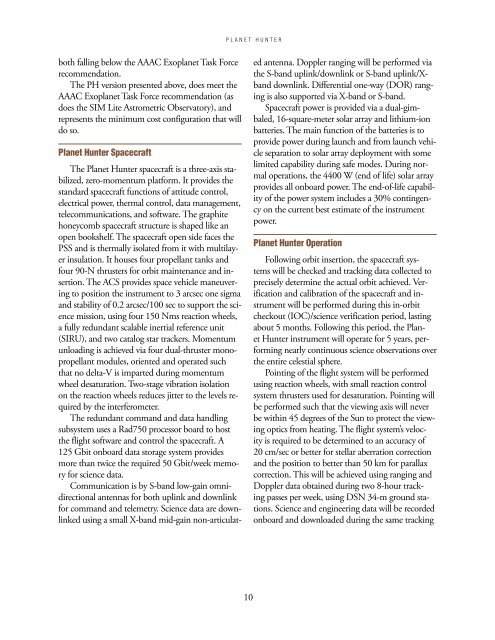Planet Hunter - Exoplanet Exploration Program - NASA
Planet Hunter - Exoplanet Exploration Program - NASA
Planet Hunter - Exoplanet Exploration Program - NASA
You also want an ePaper? Increase the reach of your titles
YUMPU automatically turns print PDFs into web optimized ePapers that Google loves.
PLANET HUNTER<br />
both falling below the AAAC <strong>Exoplanet</strong> Task Force<br />
recommendation.<br />
The PH version presented above, does meet the<br />
AAAC <strong>Exoplanet</strong> Task Force recommendation (as<br />
does the SIM Lite Astrometric Observatory), and<br />
represents the minimum cost configuration that will<br />
do so.<br />
<strong>Planet</strong> <strong>Hunter</strong> Spacecraft<br />
The <strong>Planet</strong> <strong>Hunter</strong> spacecraft is a three-axis stabilized,<br />
zero-momentum platform. It provides the<br />
standard spacecraft functions of attitude control,<br />
electrical power, thermal control, data management,<br />
telecommunications, and software. The graphite<br />
honeycomb spacecraft structure is shaped like an<br />
open bookshelf. The spacecraft open side faces the<br />
PSS and is thermally isolated from it with multilayer<br />
insulation. It houses four propellant tanks and<br />
four 90-N thrusters for orbit maintenance and insertion.<br />
The ACS provides space vehicle maneuvering<br />
to position the instrument to 3 arcsec one sigma<br />
and stability of 0.2 arcsec/100 sec to support the science<br />
mission, using four 150 Nms reaction wheels,<br />
a fully redundant scalable inertial reference unit<br />
(SIRU), and two catalog star trackers. Momentum<br />
unloading is achieved via four dual-thruster monopropellant<br />
modules, oriented and operated such<br />
that no delta-V is imparted during momentum<br />
wheel desaturation. Two-stage vibration isolation<br />
on the reaction wheels reduces jitter to the levels required<br />
by the interferometer.<br />
The redundant command and data handling<br />
subsystem uses a Rad750 processor board to host<br />
the flight software and control the spacecraft. A<br />
125 Gbit onboard data storage system provides<br />
more than twice the required 50 Gbit/week memory<br />
for science data.<br />
Communication is by S-band low-gain omnidirectional<br />
antennas for both uplink and downlink<br />
for command and telemetry. Science data are downlinked<br />
using a small X-band mid-gain non-articulated<br />
antenna. Doppler ranging will be performed via<br />
the S-band uplink/downlink or S-band uplink/Xband<br />
downlink. Differential one-way (DOR) ranging<br />
is also supported via X-band or S-band.<br />
Spacecraft power is provided via a dual-gimbaled,<br />
16-square-meter solar array and lithium-ion<br />
batteries. The main function of the batteries is to<br />
provide power during launch and from launch vehicle<br />
separation to solar array deployment with some<br />
limited capability during safe modes. During normal<br />
operations, the 4400 W (end of life) solar array<br />
provides all onboard power. The end-of-life capability<br />
of the power system includes a 30% contingency<br />
on the current best estimate of the instrument<br />
power.<br />
<strong>Planet</strong> <strong>Hunter</strong> Operation<br />
Following orbit insertion, the spacecraft systems<br />
will be checked and tracking data collected to<br />
precisely determine the actual orbit achieved. Verification<br />
and calibration of the spacecraft and instrument<br />
will be performed during this in-orbit<br />
checkout (IOC)/science verification period, lasting<br />
about 5 months. Following this period, the <strong>Planet</strong><br />
<strong>Hunter</strong> instrument will operate for 5 years, performing<br />
nearly continuous science observations over<br />
the entire celestial sphere.<br />
Pointing of the flight system will be performed<br />
using reaction wheels, with small reaction control<br />
system thrusters used for desaturation. Pointing will<br />
be performed such that the viewing axis will never<br />
be within 45 degrees of the Sun to protect the viewing<br />
optics from heating. The flight system’s velocity<br />
is required to be determined to an accuracy of<br />
20 cm/sec or better for stellar aberration correction<br />
and the position to better than 50 km for parallax<br />
correction. This will be achieved using ranging and<br />
Doppler data obtained during two 8-hour tracking<br />
passes per week, using DSN 34-m ground stations.<br />
Science and engineering data will be recorded<br />
onboard and downloaded during the same tracking<br />
10
















